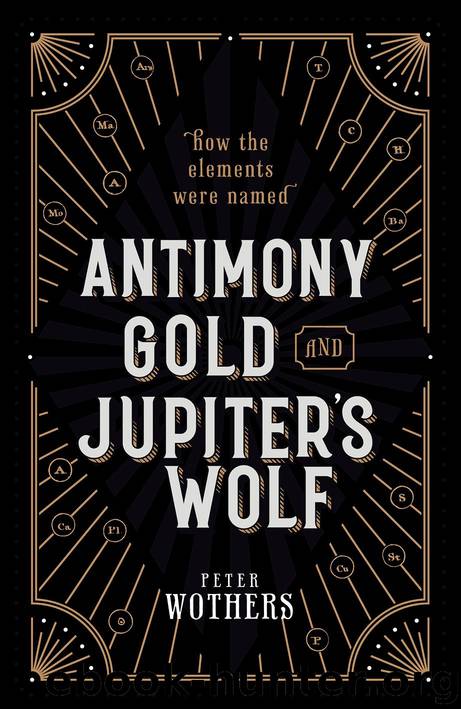Antimony, Gold, and Jupiter's Wolf by Peter Wothers

Author:Peter Wothers
Language: eng
Format: epub, azw3
ISBN: 9780192569905
Publisher: OUP Oxford
Published: 2019-09-17T16:00:00+00:00
A detailed preparation of ammonium chloride from salt and urine is described in the sixteenth century by Alexis of Piedmont in his Book of Secrets:
To prepare salte armoniacke
Take ten pounde of prepared salt, and powre upon it some warme pisse of a man that is in health, and hath not dronke but wyne, and let the salt dissolve in the sayd pisse, and go to the bottome, then straine it thorow a felt into a caudron, put to it some soute of a bakers oven, boyling it together: When this salte is drye: powre upon it some mans pisse, and do this so long untill the ten pots of urine be consumed in the ten pound of salt.26
Charmingly, Alexis warns the reader, ‘You muste take heede, that the caudron ronne not over, whan the Uryne boyleth’—wise words indeed. The original use of camel’s urine rather than human might have been, as another author puts it, since ‘’tis not so stinking’.
Heating ammonium chloride, or even just urine, with one of the fixed alkalis (the hydroxide or carbonate of either potassium or sodium) liberates ammonia gas. This was known as ‘the volatile spirit of salt ammoniack’, or ‘spirit of urine’, and is described by Glauber in his Description of New Philosophical Furnaces from 1651: ‘Out of urine or salt Armoniack a powerful and penetrating spirit may be made several wayes, which not only is to be used in physick for many diseases, but is also found very useful in mechanical and Chymical operations.’27
Glauber uses the urine ‘of sound men living chaste’ heated with ‘calcined Tartar’ (the potassium carbonate we encountered earlier), but thoughtfully adds ‘because the spirit of urine is tedious to make, therefore I will shew, how to get it easier out with salt Armoniack’. He later describes the ammonia as a spirit ‘of a sharp penetrating essence, and of an airie, moyst and warm nature’, and notes among its uses that ‘onely smelled unto it cureth the megrim and other Chronical diseases of the head: for it dissolveth the peccant matter & evacuateth it through the nostrils’.
The first person to prepare and isolate pure ammonia gas was Joseph Priestley, who prepared it by heating a mixture of ‘one fourth of pounded sal ammoniac [ammonium chloride], with three fourths of slaked lime [calcium hydroxide]’.28 Since the gas dissolves extremely readily in water, he collected the gas by the displacement of mercury rather than water. Priestley called the gas ‘alkaline air’, and ‘with the same ease I also procured this air from spirit of hartshorn, and sal volatile [ammonium carbonate] either in a fluid or solid form, i.e. those volatile alkaline salts which are produced by the distillation of sal ammoniac with fixed alkalis’. Spirit of hartshorn was an old preparation obtained by the distillation of the horns of deer. When heated, this animal matter decomposed and produced in part of the fraction aqueous ammonia and ammonium carbonate.
Download
Antimony, Gold, and Jupiter's Wolf by Peter Wothers.azw3
This site does not store any files on its server. We only index and link to content provided by other sites. Please contact the content providers to delete copyright contents if any and email us, we'll remove relevant links or contents immediately.
500 AP Chemistry Questions to Know by Test Day(1215)
MCAT General Chemistry Review 2019-2020 by Kaplan Test Prep(1148)
The Great Mental Models Volume 2 by Shane Parrish(1103)
500 AP Chemistry Questions to Know by Test Day by Mina Lebitz(1062)
5 Steps to a 5 by John T. Moore(995)
Rules for Writers by Diana Hacker & Nancy Sommers(880)
MCAT General Chemistry Review by Princeton Review(845)
Cracking the SAT Chemistry Subject Test, 1 by Princeton Review(828)
Ingredients by George Zaidan(766)
The MCAT Chemistry Book by Aryangat Ajikumar(729)
A Rulebook for Arguments by Weston Anthony;(699)
MCAT Organic Chemistry Review by Princeton Review(680)
MCAT General Chemistry Review 2020-2021 by Kaplan Test Prep(607)
Kaplan MCAT General Chemistry Review: Created for MCAT 2015 (Kaplan Test Prep) by Kaplan(589)
5 Steps to a 5 by Mina Lebitz(588)
The Elements We Live By: How Iron Helps Us Breathe, Potassium Lets Us See, and Other Surprising Superpowers of the Periodic Table by Anja Røyne(566)
5 Steps to a 5: AP Chemistry 2017 by Moore John T. & Langley Richard H(554)
5 Steps to a 5 AP Chemistry 2014-2015 by Richard H. Langley & John T. Moore(532)
5 Steps to a 5 500 AP Biology Questions to Know by Test Day by Mina Lebitz(487)
